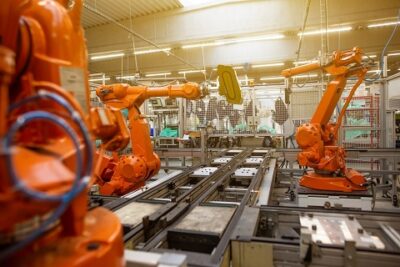For years, Taiwan’s TSMC and ASE were making the lion’s share of the world’s semiconductor chips. Those days may be over. In the coming years, thanks to the Biden administration, we may see a US-led semiconductor industry.
Competition may yet get fierce in the semiconductor manufacturing industry in the US. Companies have to fast-forward through decades of progress to catch up with Taiwan. If you have a semiconductor manufacturing company, how can you improve it?
Let’s take a look at eight ways you can improve operations.
1. Use the Latest Tech
In some industries, you can afford to stick with tried-and-tested production methods and practices. That’s not the case with the semiconductor manufacturing industry. Semiconductor production is the sort that moves at a breakneck pace of innovation year after year.
In the 60s, semiconductors were as small as 20,000 nm. By the 80s, they were less than 100 nm. Now in recent years, we’ve reached 3nm, and we may yet decrease that size.
Doing this requires the latest, most advanced machinery. In the industry, it’s common knowledge that you will be retooling your factories practically on a monthly basis. Anticipate this in your budget and don’t resist saving some money.
2. Find Quality Silicon Wafers
Silicon wafers are your lifeblood. These are circular, pressed, and patterned wafers that your machines then transform and cut into semiconductor chips. Unlike machinery, you don’t need to make them in-house.
However, you should find a high-quality and reliable manufacturer partner. A semiconductor is only as good as the substrate you build on.
Plus, you need to ensure that you have regular shipments of these wafers to keep production going. During the pandemic, it wasn’t just slow production that led to supply shortages. It was also because the wafers were not making it to the semiconductor factories in the first place.
Get started buying wafers at silybwafers.com/.
3. Focus on Yield
The thing with semiconductor manufacturing is that every batch is a mixture. You get high-quality chips that will command a premium, mixed with lower-quality chips for less demanding requirements.
This is known as the “silicon lottery” where devices with the same chip will get differing levels of efficiency. This results in some chips performing much better at lower wattages. This forces device manufacturers to underclock them to match the performance of other devices.
Thus, it’s much better to focus on a high yield than on making all chips meet the same requirements.
4. Quality Control
Every chip should undergo a rigorous inspection once off the assembly line. This isn’t just to determine how much of your yield can go out for sale. It’s also a metric to determine what is going wrong (or right) in the production process.
For example, there may be issues with particle control. The rooms may not be sufficiently clean, which spoils the semiconductor chips that you produce. Improving cleanroom standards will make a huge difference.
Plus, there should be a system of quality control for chips that have left the factory. If a company reports device overheating issues or challenges with efficiency, this is a clear sign something may have gone wrong. It’s a great chance to innovate or identify a potential problem.
5. Focus on General Formats
There are very few companies out there that require microchips to adhere to specific certifications. That is, most of them buy chips in bulk and adapt them to their systems after the fact. Few companies, such as giants like Apple, have stringent and bespoke requirements.
Granted, there are companies out there that specialize in customized chips and circuitry, such as Teenage Engineering. However, this does not lend itself to high profitability or versatility in a competitive industry.
6. Use AI
AI has already been a part of the semiconductor production process, and it will only become more of a part with time. The machines that make silicon wafers run almost entirely autonomously. Your job is just to make sure they stay running, and smoothly.
Recent history has shown that companies that don’t keep up with AI fall behind. AI is a driving force and almost all major innovations these days. It will be designing our chips, our machines, and in this case, building them to use them.
7. Keep on Top of Research
Moore’s Law tells us that semiconductors will continue to improve, but not indefinitely. Semiconductors are approaching the atomic scale. Soon, we won’t be able to make them any smaller.
New issues will arise, such as quantum mechanics causing these incredibly small semiconductors to malfunction. As a result, we will need new materials and new designs.
Researchers are working tirelessly to figure out what the next type of classical computing will look like. For some, it’s spintronics; for others, it’s using fiberoptic connections between components.
There are going to be changes in storage mediums. Recently, the industry moved to NVME drives. The next move may be to better-unified memory, similar to that in Apple devices.
It’s impossible to say what the future will look like, but one thing is certain: companies that don’t pay attention will die.
8. Don’t Build Only 3nm
3nm was the Holy Grail of silicon, and TSMC only recently achieved it at scale for the iPhone 15. There’s no doubt we will continue to get smaller semiconductors. Processors will continue to put out more power with greater efficiency.
That said, it’s important not to miss the forest for the trees. Not every device on the planet needs a 3nm chip, despite it being around since 2006. Many devices have very limited requirements and run on “old” 15nm processes.
The point is, that there is still plenty of room in the industry for bigger, less efficient, less powerful chips. Don’t make the mistake of cutting production for them to chase the latest and greatest. There will always be things like vending machines and handheld thermometers that are fine with a chip pioneered in the 80s.
Improve Your Semiconductor Manufacturing Company
Building a semiconductor manufacturing company won’t be easy, but it will be profitable if you do it right. Use the above tips to improve your processes and stay competitive. With luck, you may be the next TSMC, albeit on this side of the pond.
Follow our blog for more great articles, like this one, on Business and Technology.










